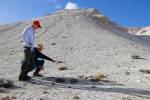UNLV prof wins mineral (naming) rights
It is Earth’s most abundant mineral, but it didn’t even have a name until a pair of researchers from UNLV and the California Institute of Technology gave it one last month.
Bridgmanite, as it is now known, is thought to make up about 38 percent of the planet, but it only exists under the intense heat and pressure at least 400 miles below the surface.
“It is basically the major mineral of the lower mantle down to the Earth’s core,” UNLV mineral physicist Oliver Tschauner said. But it doesn’t exist on the surface because it can’t escape the planet’s interior without being transformed into something else on the way up.
Tschauner and Caltech mineralogist Chi Ma earned the honor of naming the substance earlier this year when they became the first to describe its chemical composition and crystal structure after five years trying.
In the process, the duo completed a 35-year quest by scientists around the world to actually find a sample of the mineral, the existence of which was first theorized in 1979.
As it turned out, the answer literally had fallen from the sky 100 years earlier.
Tschauner and Ma finally found the elusive mineral in a meteorite that crashed in Australia in 1879 and eventually ended up in the British Museum.
The meteorite is available for research — and has yielded other mineral discoveries — so the two researchers ordered up a piece of the space rock about the size of an M&M.
Tschauner said it already was believed that collisions between meteors might duplicate the heat and pressure found inside the Earth and could produce grains of bridgmanite. But examining grains so tiny and delicate proved impossible; the electron beam from the world’s most powerful microscopes would cause the structures to collapse into glass.
Tschauner and Ma’s solution was to use micro-focused, high-energy X-ray beams to analyze the mineral’s structure without destroying it. It was painstaking work that required them to use a new ultrafast X-ray detector in Chicago to find grains of the mineral roughly 10,000 times smaller than the width of a dime.
Tschauner likened it to entering a forest filled with different plants in search of one specific flower.
“It was hard. It was probably the hardest thing I’ve done,” said the German-born researcher, who has now been involved in the description of nine new minerals.
Naming their discovery turned out to be the easy part. Shortly before they submitted their findings for publication, Tschauner and Ma stumbled across a discussion about that very subject on an online science message board.
The commenters overwhelmingly favored naming the ubiquitous inner-Earth mineral after the late Percy Bridgman, a Nobel-Prize-winning physicist who pioneered high-pressure research and the equipment needed to conduct it during his career at Harvard.
“It was like magic,” Tschauner said.
The mineral and its name were approved on June 2 by the arbiters of such things, the International Mineralogical Association’s Commission on New Minerals, Nomenclatures and Classification.
Tschauner said the meteorite fragment containing the type specimen of bridgmanite will be kept at the Smithsonian — a candy-sized vessel for something both incredibly common and impossibly rare.
Contact Henry Brean at hbrean@reviewjournal.com or 702-383-0350. Follow @RefriedBrean on Twitter.




























